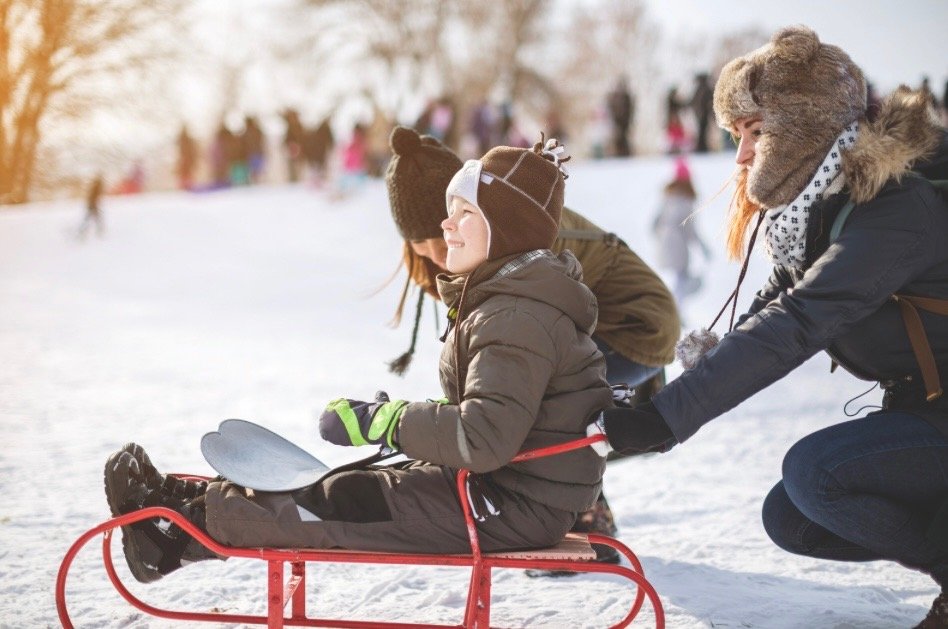Six Ways to Enjoy More Outdoor Play During the Cold Winter Months
If you live in a region where the winters are frigid and dark and LONG, then you are probably familiar with the feeling of dread that ensues when the temperatures begin to drop in October or November. As a professional nanny in Chicago, I’ve come to learn the intricacies of this city’s weather (as best as one can with all its unpredictability!), and there’s a point every fall where Mother Nature seems to say, “Buckle up, baby, we’ve got a rough winter ahead!” A chill sets in, and along with it, a deep sadness, as we bid farewell to long summer days camped out at the splash pad and warm afternoons spent on the lakefront and bright mornings filled with park hopping and leaf collecting.
Poof! Gone in an instant!
And then we put our heads down and just do everything we can to get through the next several months. Survival.
But as a firm believer in the power of a good reframe, I’ve started to ask:
Can we do more than “get through” the frigid winter months?
You see, I think there really is something to the Scandinavian philosophy that “there’s no such thing as bad weather, only bad clothing.” Obviously there is a level of discernment that comes along with this discussion, but the possibilities for outdoor play become limitless when we let go of our desire to label weather as “good” or “bad” and just let it be.
Then we can begin to effectively prepare for it. And that’s what outdoor winter play is all about: preparation. How can we make this time outside bearable and—dare I say it—even enjoyable?
Here are six ways:
Layer, Layer, Layer!
First and foremost, layers are your best friend here. And this goes for both the kids and for you. You’ll want to start with a more form-fitting base layer, ideally in a material like merino wool, followed by a mid layer of wool or fleece for trapping body heat. An outer layer like a waterproof/windproof winter coat is excellent for keeping out moisture. Of course, you can always add more layers if the weather calls for it, but the beauty of layers is that they are adaptable! Should you or your little ones get too warm during an activity, a layer can always be shed.
Accessorize!
When it comes to accessories, trapping in body heat is still the name of the game. Tall wool socks are key, as well as a wool hat or beanie. As far as gloves/mittens are concerned, waterproof is the way to go, especially if you are playing in the snow. Add some durable boots that allow ample room for movement and some insulated snow pants, and you’ll soon be on your way out the door!
say no to cotton!
Be sure to avoid materials like cotton, if you can. Cotton absorbs and retains moisture, and on an especially chilly day, you should try to stay as dry as possible. As already mentioned above, you want to wear materials like merino wool that wick away moisture, as opposed to holding on to it.
stay active!
Try to have some sort of plan before you head outside. Are you going to sled? Build a fort? Play tag? Go on a winter scavenger hunt or hike? Have some ideas, but also be sure to allow for child-led play. Whatever the activity, the goal should be to keep your bodies moving because the body stays warmer when it’s active.
Bring a warm beverage!
A thermos full of homemade hot cocoa or warm apple cider is sure to be a crowd-pleaser when you’re out and about in the snow or the cold. Aside from cocoa or cider, it’s also important for everyone to stay hydrated with water. In the colder months, you might not feel as thirsty, so it’s important to make a deliberate, conscious effort with this. And if bringing a thermos along doesn’t feel feasible, enjoy making the warm beverages together when you get home! There’s nothing better than coming home to hot cocoa and cozy blankets after a cold adventure outside.
be realistic.
This one is HUGE! It’s important to use reason and to practice discernment when the weather is particularly frigid or treacherous. Maybe you can only go outside for a very short window of time or maybe it’s not safe to go out at all (as a Chicago nanny, I’m no stranger to the polar vortex). Build a fort inside, set up an obstacle course, do a bake-off, or even consider heading to a local nature museum. My favorite in the area is the Peggy Notebaert Nature Museum.
Getting outside with little ones in the winter can feel like a BIG undertaking, and while we may not be able to spend hours and hours outside like in the warmer months, with the right preparation, it still is possible and important.
kids thrive when they are able to stay active in nature.
Plus, the new weather conditions can offer new opportunities for problem solving, discovery, and motor skill development. On days when it’s sunny, you’ll all be able to get that dose of Vitamin D! And even when it’s not sunny, time in nature can help to lower stress levels and to better sleep. Nature offers a seemingly endless “yes” space, and being outside is the ultimate sensory experience. If we live in a place that gets really cold in the wintertime, we shouldn’t have to put all of these things on hold for months every year.
My hope is that this reframe can help you in the same way it helped me. I hope we can all do a little more having fun and a little less getting through this winter. And with that I say, get outside! Stay safe, stay warm, keep playing.
And if you’re a caregiver looking for other ideas and resources to combat the winter blues, consider taking a look at one of our previous blog posts: How To Avoid the Winter Blues.
As always, we’d love it if you followed along on our Instagram page, where we post more info and insights for nannies and families. Thank you for being here at Nanny Harmony!

